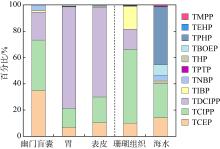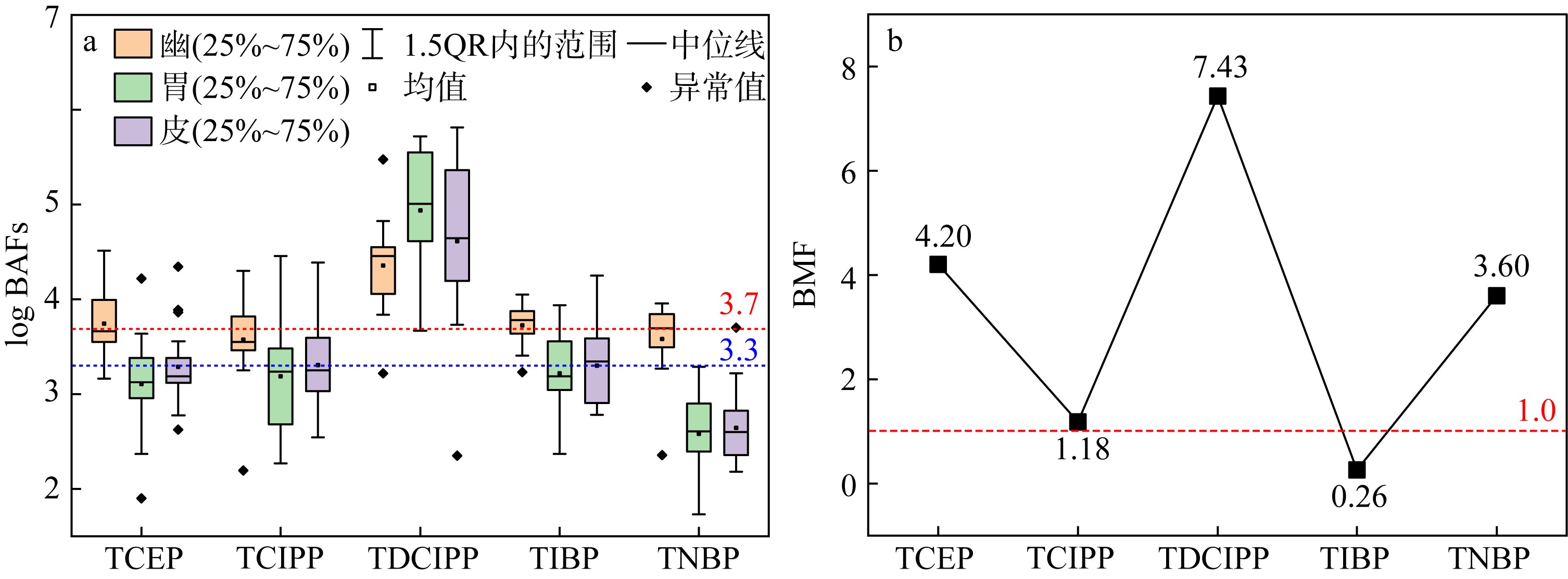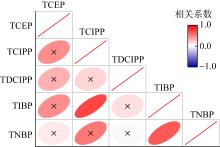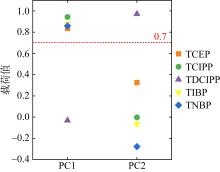Journal of Tropical Oceanography ›› 2023, Vol. 42 ›› Issue (5): 30-37.doi: 10.11978/2022223CSTR: 32234.14.2022223
• Marine Chemistry • Previous Articles Next Articles
Bioaccumulation characteristics and source apportionment of organophosphate esters in Acanthaster planci from the South China Sea
WANG Chenyan1( ), SHI Jingwen1, YAN Annan1, KANG Yaru1, WANG Yuxuan1, QIN Suli1, HAN Minwei1, ZHANG Ruijie1,2,3(
), SHI Jingwen1, YAN Annan1, KANG Yaru1, WANG Yuxuan1, QIN Suli1, HAN Minwei1, ZHANG Ruijie1,2,3( ), YU Kefu1,2,3
), YU Kefu1,2,3
- 1. School of Marine Sciences, Guangxi University, Nanning 530004, China
2. Coral Reef Research Center of China, Guangxi University, Nanning 530004, China
3. Guangxi Laboratory on the Study of Coral Reefs in the South China Sea, Nanning 530004, China
-
Received:2022-10-19Revised:2022-12-16Online:2023-09-10Published:2022-12-19 -
Supported by:Guangxi Natural Science Foundation(2020GXNSFDA297005); Guangxi Laboratory on the Study of Coral Reefs in the South China Sea Independent Project(GXLSCRSCS2021101); Innovation and Entrepreneurship Training Program of Guangxi University(202210593887); National Natural Science Foundation of China(42030502); National Natural Science Foundation of China(42090041)
Cite this article
WANG Chenyan, SHI Jingwen, YAN Annan, KANG Yaru, WANG Yuxuan, QIN Suli, HAN Minwei, ZHANG Ruijie, YU Kefu. Bioaccumulation characteristics and source apportionment of organophosphate esters in Acanthaster planci from the South China Sea[J].Journal of Tropical Oceanography, 2023, 42(5): 30-37.
share this article
Add to citation manager EndNote|Reference Manager|ProCite|BibTeX|RefWorks
Tab. 1
Detection rates and concentrations of OPEs in different tissues of Acanthaster planci (dry weight) from the South China Sea (unit: ng·g-1)"
| OPEs | 幽门盲囊(n=16) | 胃(n=17) | 表皮(n=24) | |||||||||
|---|---|---|---|---|---|---|---|---|---|---|---|---|
| 检出率/% | 范围 | 平均值± 标准差 | 中位数 | 检出率/% | 范围 | 平均值± 标准差 | 中位数 | 检出率/% | 范围 | 平均值± 标准差 | 中位数 | |
| TCEP | 100 | 14.6~532 | 124±150 | 67.3 | 100 | 4.68~153 | 37.2±41.2 | 20.2 | 100 | 3.32~61.4 | 17.4±15.3 | 11.4 |
| TCIPP | 100 | 2.87~552 | 138±148 | 87.5 | 100 | 6.22~485 | 78.2±107 | 45.5 | 100 | 5.07~115 | 33.1±28.9 | 22.7 |
| TDCIPP | 81 | nd~319 | 75.3±105 | 34.6 | 88 | nd~1086 | 421±353 | 397 | 100 | 0.19~486 | 115±147 | 39.2 |
| TIBP | 100 | 0.50~11.3 | 4.61±2.65 | 4.70 | 82 | nd ~5.54 | 1.74±1.63 | 1.13 | 88 | nd~2.60 | 1.11±0.76 | 1.13 |
| TNBP | 88 | nd~35.7 | 15.0±10.2 | 12.8 | 76 | nd ~4.82 | 1.45±1.39 | 1.28 | 79 | nd~2.95 | 0.92±0.78 | 0.85 |
| TPTP | 0 | nd | nd | nd | 0 | nd | nd | nd | 8 | nd~0.57 | 0.04±0.13 | nd |
| THP | 0 | nd | nd | nd | 0 | nd | nd | nd | 0 | nd | nd | nd |
| TBOEP | 13 | nd ~5.33 | 0.46±1.35 | nd | 18 | nd~50.9 | 4.69±12.6 | nd | 17 | nd~6.73 | 0.88±2.00 | nd |
| TPHP | 0 | nd | nd | nd | 0 | nd | nd | nd | 0 | nd | nd | nd |
| TEHP | 13 | nd~0.40 | 0.03±0.10 | nd | 12 | nd~2.08 | 0.24±0.67 | nd | 8 | nd~1.47 | 0.12±0.39 | nd |
| TMPP | 0 | nd | nd | nd | 0 | nd | nd | nd | 0 | nd | nd | nd |
| ∑11OPEs | 60.2~1130 | 357±298 | 262 | 68.2~1181 | 544±409 | 487 | 9.31~569 | 169±161 | 97.0 | |||
Tab. 2
Detection rates and concentrations of OPEs in coral tissues (dry weight) (unit: ng·g-1) and seawater (unit: ng·L-1) from the South China Sea"
| OPEs | 珊瑚组织(n=9) | 海水(n=2) | ||||||
|---|---|---|---|---|---|---|---|---|
| 检出率/% | 范围 | 平均值±标准差 | 中位数 | 检出率/% | 范围 | 平均值±标准差 | 中位数 | |
| TCEP | 22 | nd ~96.5 | 11.9±30.1 | nd | 100 | 1.78~2.60 | 2.19±0.41 | 2.19 |
| TCIPP | 33 | nd ~278 | 66.9±105 | nd | 100 | 2.45~5.61 | 4.03±1.58 | 4.03 |
| TDCIPP | 11 | nd~166 | 18.5±52.2 | nd | 100 | 0.20~0.26 | 0.23±0.03 | 0.23 |
| TIBP | 78 | nd ~87.0 | 20.6±25.3 | 19.0 | 100 | 0.08~0.21 | 0.15±0.06 | 0.15 |
| TNBP | 11 | nd~4.86 | 0.54±1.53 | nd | 100 | 0.50~0.68 | 0.59±0.09 | 0.59 |
| TPTP | 0 | nd | nd | nd | 0 | nd | nd | nd |
| THP | 0 | nd | nd | nd | 0 | nd | nd | nd |
| TBOEP | 0 | nd | nd | nd | 100 | 0.18~2.38 | 1.28±1.10 | 1.28 |
| TPHP | 11 | nd~4.73 | 0.53±1.49 | nd | 100 | 5.16~8.42 | 6.79±1.63 | 6.79 |
| TEHP | 11 | nd~2.97 | 0.33±0.93 | nd | 100 | 0.05~0.08 | 0.06±0.02 | 0.06 |
| TMPP | 0 | nd | nd | nd | 100 | 0.09~0.27 | 0.18±0.09 | 0.18 |
| ∑11OPEs | nd~461 | 119±163 | 19.8 | 15.0~16.0 | 15.5±0.45 | 15.5 | ||

Fig. 2
∑11OPEs in different tissues of Acanthaster planci from the South China Sea. (a) Differences in the content of ∑11OPEs (dry weights) in different tissues of Acanthaster planci from the South China Sea; (b) Differences in the content of ∑11OPEs (lipid weights) in different tissues of Acanthaster planci from the South China Sea"
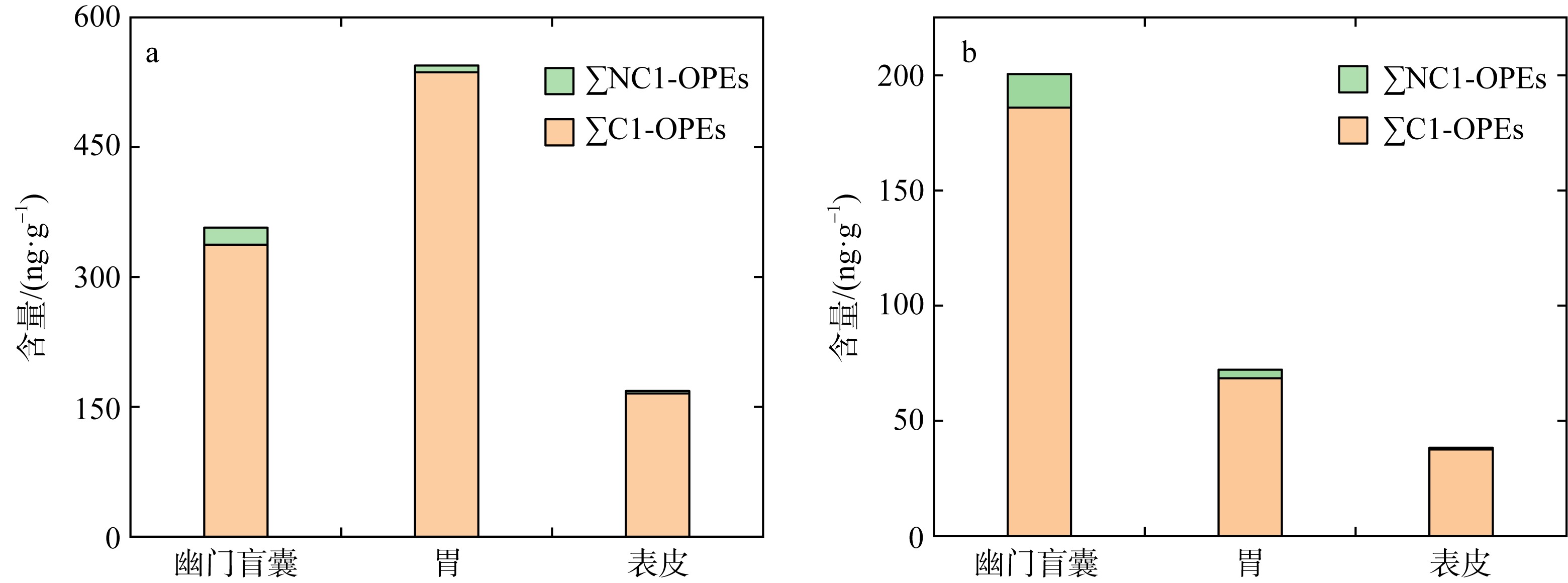
| [1] |
李厚金, 李淑青, 王丰, 等, 2009. 长棘海星的体内脂肪酸成分及其生物学意义分析[J]. 中山大学学报(自然科学版), 48(5): 55-60.
|
|
|
|
| [2] |
李元超, 梁计林, 吴钟解, 等, 2019. 长棘海星的暴发及其防治[J]. 海洋开发与管理, 36(8): 9-12.
|
|
|
|
| [3] |
廖梓聪, 李会茹, 杨愿愿, 等, 2022. 有机磷酸酯(OPEs)的环境污染特征、毒性和分析方法研究进展[J]. 环境化学, 41(4): 1193-1215.
|
|
|
|
| [4] |
吕佳佩, 张振飞, 刘杨, 等, 2020. 太湖重点区域多介质水体中有机磷酸酯的分布特征及来源解析[J]. 环境科学, 41(12): 5438-5447.
|
|
|
|
| [5] |
陆运涛, 赵赛, 仇雁翎, 等, 2018. 塘西河沉积物中有机磷酸酯的污染现状及来源解析[J]. 环境污染与防治, 40(5): 604-608.
|
|
|
|
| [6] |
彭晓彤, 钟广法, 2020. 南海深海塑料垃圾污染[J]. 科技导报, 38(18): 99-104.
|
|
|
|
| [7] |
张文萍, 张振飞, 郭昌胜, 等, 2021. 环太湖河流及湖体中有机磷酸酯的污染特征和风险评估[J]. 环境科学, 42(4): 1801-1810.
|
|
doi: 10.1021/es7022913 |
|
| [8] |
赵思佳, 张媛媛, 余克服, 等, 2022. 南海珊瑚礁区棘冠海星重金属含量及其生物积累特征分析[J]. 海洋环境科学, 41(4): 579-585.
|
|
|
|
| [9] |
朱金财, 马玉欣, 蔡明红, 2021. 海洋环境PAHs研究进展: 来源、分布及生物地球化学过程[J]. 海洋环境科学, 40(3): 468-476.
|
|
|
|
| [10] |
doi: 10.1021/acs.est.6b04344 |
| [11] |
doi: 10.1016/j.marpolbul.2022.113779 |
| [12] |
doi: 10.1016/j.envint.2020.105919 |
| [13] |
EUROPEAN CHEMICALS AGENCY, 2017. Guidance on information requirements and chemical safety assessment: Chapter R. 11: PBT/vPvB assessment (Version 3.0)[L].
|
| [14] |
doi: 10.1021/acs.est.7b01289 |
| [15] |
doi: 10.1016/j.envpol.2022.118792 |
| [16] |
doi: 10.1021/acs.est.7b00755 |
| [17] |
pmid: 14512118 |
| [18] |
doi: 10.1016/j.scitotenv.2015.02.008 |
| [19] |
doi: 10.1016/j.envpol.2021.118377 |
| [20] |
doi: 10.1016/j.envpol.2014.12.037 pmid: 25603156 |
| [21] |
doi: 10.1016/j.chemosphere.2021.132125 |
| [22] |
doi: 10.1016/j.marpolbul.2021.112691 |
| [23] |
doi: 10.1016/j.envpol.2020.114426 |
| [24] |
doi: 10.1016/j.envpol.2022.118873 |
|
||


